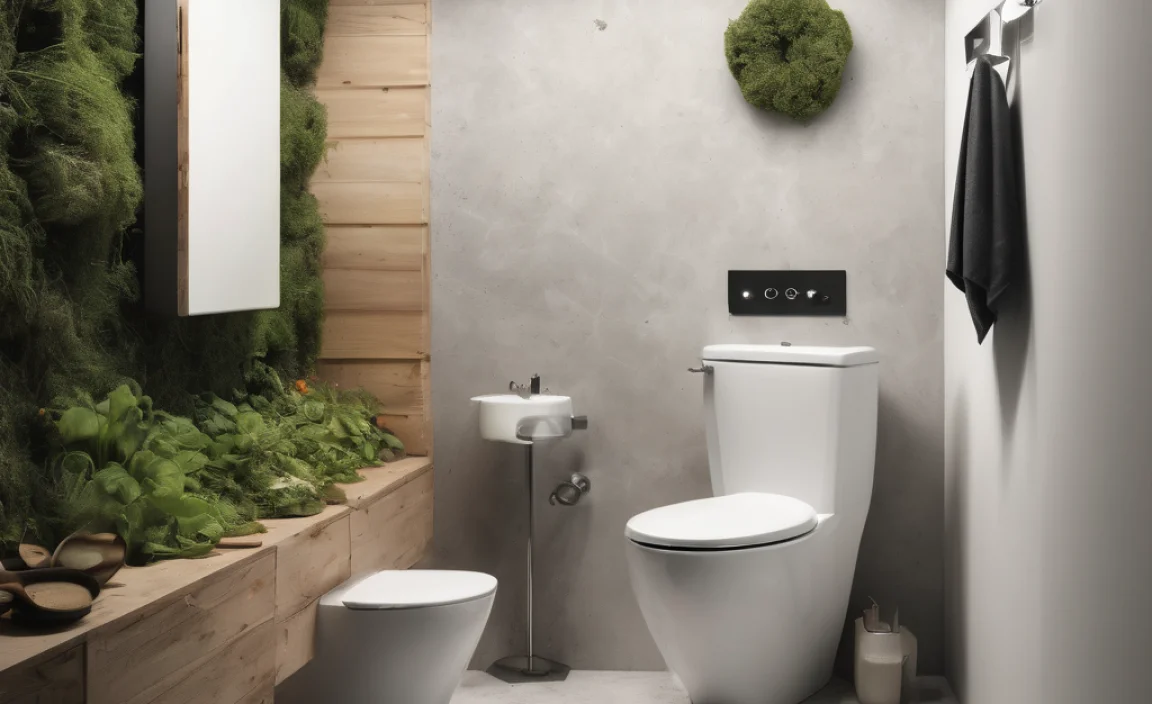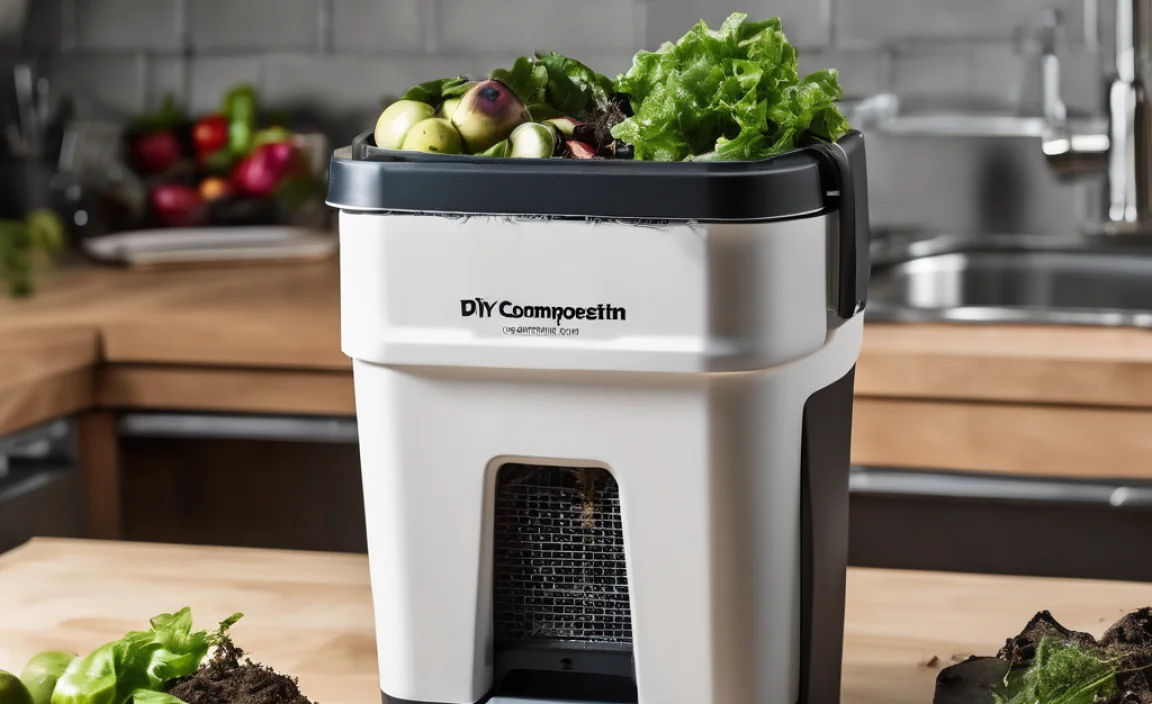Got creepy crawlies in your office compost bin? Don’t sweat it! Sometimes, our office composting efforts attract more guests than we bargained for. It’s a common hiccup, but totally fixable. With a few simple tweaks and smart tips, we can get our office compost humming along happily, breaking down waste without the unwanted bug parade. Ready to create a bug-friendly (for the right bugs!) compost system? Let’s dive in and make your office compost a success story.
Composting for Offices: Taming the Bugs for a Greener Workspace
Hey there! Troy D Harn here, your go-to for making life a little easier, whether it’s in the garden, around the house, or right here in the office. Today, we’re tackling a topic that might seem a little… buggy. We’re talking about composting in the office, and specifically, what to do when unwelcome insects decide to move in. It’s a common puzzle, but one with simple, practical solutions. We’ll walk through why it happens, how to prevent it, and what to do if you’ve already got some unexpected guests. Let’s get your office compost working for you, not against you!
Why Bugs Show Up in Your Office Compost
Before we start swatting, let’s understand why bugs, especially the less desirable ones, might be attracted to your office compost bin. Think of your compost bin as a buffet for certain creatures. They’re drawn to food scraps, moisture, and warmth. Sometimes, an imbalance in what you’re adding or how you’re managing the bin can create an environment that’s just perfect for them. It’s usually a sign that something in the compost ecosystem needs a little adjustment, not that you’re doing anything wrong!
The Usual Suspects: Common Office Compost Critters
Most of the bugs you find in a compost bin are actually beneficial. They’re nature’s tiny recyclers! But a few can become a nuisance if their population booms.
- Fruit Flies: These tiny invaders love the sweet, fermenting fruit and vegetable scraps. They reproduce quickly, especially in warmer conditions.
- Ants: Often attracted by moisture or very ripe food items. They can sometimes take over if the compost is too dry or if there’s a persistent food source they can access easily.
- Gnats: Similar to fruit flies, fungus gnats are attracted to moist organic matter. They’re a common sight in damp environments.
- Mites: Tiny, often microscopic, mites are usually a sign of actively decomposing material and are generally harmless, even beneficial decomposers.
- Silverfish: These can appear if the compost is too damp and has a lot of starchy materials like paper.
The Root Cause: What Attracts Unwanted Office Compost Bugs?
Understanding the ‘why’ is half the battle. Most bug problems in office composting stem from a few key issues:
- Too Much Moisture: A soggy compost bin is a breeding ground for flies and gnats. This can happen if you’re adding a lot of wet food scraps without enough dry material to balance it.
- Exposed Food Scraps: If food scraps are left sitting on top of the pile, they become an easy target for fruit flies and ants.
- Improper Bin Type/Seal: Some bins aren’t designed to keep bugs out effectively, especially if they have large vents or aren’t cleaned regularly.
- Not Enough Aeration: Poor airflow can lead to anaerobic conditions (lack of oxygen), creating odors that attract pests and can also contribute to sogginess.
- What You’re Adding: Certain food items, like dairy or meat scraps (which are often best avoided in small-scale or office composting), can be particularly attractive to pests and may not break down well in all systems.
Solutions to Keep Office Compost Bugs at Bay
Don’t worry, fixing these issues is usually straightforward. It’s all about creating a balanced, healthy compost environment that works for you.
Step 1: Choose the Right Compost Bin for Your Office
The first line of defense is your bin. For an office setting, look for something that’s:
- Enclosed: A sealed lid is crucial. This prevents flies from getting in and out and reduces odors.
- Well-Ventilated: Proper airflow is key to preventing moisture buildup and odors. Look for bins with small, well-placed vents.
- Easy to Clean: A bin that’s simple to empty and wipe down will help prevent lingering food residue.
- Appropriately Sized: Don’t get a bin that’s too big if you don’t generate a lot of compostable waste. Too much space can lead to stagnation.
Consider a bin specifically designed for kitchen or indoor composting. These are typically smaller and come with features to manage moisture and pests.
Step 2: Master the “Green” and “Brown” Balance
Composting works best when you have a good mix of “greens” (nitrogen-rich materials) and “browns” (carbon-rich materials). In an office setting, this is extra important because your greens often come from fruit and veggie scraps.
Greens (Nitrogen-rich):
- Fruit peels and scraps
- Vegetable scraps
- Coffee grounds and paper filters
- Tea bags (check for plastic components)
Browns (Carbon-rich):
- Paper towels (check for harsh chemicals)
- Shredded plain paper or cardboard
- Cardboard egg cartons (small pieces)
- Wood chips (less common in offices, but good if available)
Why balance matters: Too many greens lead to a wet, stinky mess that attracts bugs. Too many browns can slow down decomposition. A good rule of thumb for office composting is to aim for roughly 2-3 parts browns to 1 part greens.
| Material Type | Examples for Office Use | Contribution | Why it’s Important |
|---|---|---|---|
| Greens (Nitrogen) | Fruit cores, vegetable scraps, coffee grounds, tea bags | Provides moisture and nitrogen for heat and microbial activity | Too much = soggy and smelly; attracts pests |
| Browns (Carbon) | Shredded paper, paper napkins, cardboard scraps, paper towels | Provides carbon, structure, and aeration; balances moisture | Too much = slow decomposition; not enough = soggy |
Step 3: Bury Your Food Scraps
This is a game-changer for preventing fruit flies and gnats. Every time you add fresh food scraps (your greens), cover them immediately with a layer of browns. It’s like tucking your food scraps into a cozy, dry bed of paper or cardboard. This helps to:
- Mask odors that attract pests.
- Absorb excess moisture.
- Prevent flies from getting direct access to the food.
Think of it as an ongoing maintenance task. Just a handful of shredded paper over your new scraps can make a huge difference.
Step 4: Keep it Aerated
Compost needs air to break down efficiently. Stagnant, oxygen-deprived compost can turn mushy and smelly, inviting the wrong kind of bugs.
- Stir Often: If your bin allows, give it a gentle stir every so often with a small trowel or stick. This helps introduce air and mixes the greens and browns.
- Ventilation Holes: Ensure the vent holes on your bin aren’t blocked.
For smaller office bins, regular stirring is key. Aim for at least once a week, or more if you notice it getting damp.
Step 5: Manage Moisture Levels
Moisture is essential, but too much is the enemy. Your compost should feel like a wrung-out sponge – damp, but not dripping.
- Too Wet? Add more browns! Shredded cardboard, paper towels, or even a bit of sawdust (if available) can help soak up excess moisture.
- Too Dry? Lightly mist with water. However, in an office setting, this is less common; usually, the issue is too much moisture from food scraps.
Always start by adding more browns when you add new food scraps. This proactive approach helps manage moisture from the get-go.
Step 6: What NOT to Compost in an Office Bin
While office composting is great, not everything belongs in a small-scale or indoor system. To minimize bugs and odors, avoid:
- Meats, bones, and dairy: These spoil quickly and are highly attractive to pests and can cause strong odors.
- Oily foods: Can create unpleasant smells and attract pests.
- Diseased plants: Can spread issues.
- Pet waste: Requires specific composting methods.
- Chemically treated paper products: While plain paper is fine, glossy magazines or heavily inked paper might not be ideal and can introduce chemicals.
Sticking to fruits, vegetables, coffee grounds, and tea bags is usually your safest bet for an office environment.
Troubleshooting Common Office Compost Bug Issues
Even with the best intentions, you might encounter a bug or two. Here’s how to handle common problems:
Problem: You See Fruit Flies or Gnats Hovering
Likely Cause: Exposed food scraps, too much moisture.
Solutions:
- Immediately bury any exposed food scraps under a generous layer of browns.
- Ensure your bin has a tight-fitting lid.
- If the problem persists, consider adding a thin layer of activated carbon to your compost. It can help absorb odors that attract them.
- Make sure you’re not adding too many highly sugary or fermenting items without enough browns.
For a quick fix, you can place a small bowl with a bit of apple cider vinegar and a drop of dish soap near the bin. Fruit flies are attracted to the vinegar and get trapped by the soap.
Problem: Ants Are Marching In
Likely Cause: Compost is too dry, or there’s a persistent, accessible food source.
Solutions:
- If the compost is too dry, lightly mist it with water.
- Ensure the lid is sealing properly and there are no gaps ants can exploit.
- Make sure food scraps are consistently covered with browns to remove the immediate food attraction.
- Ants are sometimes drawn to the heat of decomposition, so ensure a good balance of materials and regular turning if possible.
Problem: It Smells Like Compost Gone Bad
Likely Cause: Too wet, not enough air, or improper materials (like meat/dairy).
Solutions:
- Add a lot of browns immediately.
- Stir the compost to improve aeration.
- If you suspect you’ve added prohibited items (like meat or dairy), carefully remove them if possible.
- Ensure your bin has adequate ventilation.
A healthy compost pile should smell earthy, not foul. If it smells bad, it’s a strong indicator of underlying issues.
The Role of Beneficial Organisms
It’s worth reiterating that not all bugs are the enemy! In a healthy compost system, you’ll find beneficial organisms like:
- Earthworms: These are the superstars of composting. They eat organic matter, aerate the pile, and create nutrient-rich castings.
- Springtails: Tiny, white, jumping insects that are excellent decomposers of fungi and mold.
- Beneficial Mites: Various mites are also part of the healthy compost crew, breaking down organic matter.
The goal isn’t to eliminate all bugs, but to ensure the ones working to break down your waste ecosystem are thriving, and the nuisance pests aren’t taking over.
Making Office Composting a Team Effort
The success of office composting often hinges on everyone pitching in and understanding the basics. Here are some tricks:
- Clear Signage: Post a simple list of what can and cannot be composted near the bins.
- Designated “Compost Captains”: If possible, have a small group responsible for monitoring the bins, adding browns, and ensuring proper management.
- Regular Emptying: Don’t let the office compost bin get too full before emptying it into a larger system (if you have one) or disposing of it properly. Overflowing bins are more prone to pests.
- Educate New Hires: Make composting part of the office induction process.
For more in-depth information on composting basics, the U.S. Environmental Protection Agency (EPA) offers comprehensive guidelines on how composting works and its benefits.
Conclusion: Your Bug-Free Office Compost Awaits
Composting in the office is a fantastic way to reduce waste and boost your company’s green initiatives, and it doesn’t have to come with a side of unwanted guests. By understanding what attracts common office compost bugs – usually excess moisture, exposed food, and poor aeration – you can easily implement simple solutions.
Choosing the right bin, mastering the green-to-brown ratio, diligently burying food scraps, and ensuring good airflow are your key strategies. Remember, a little proactive management goes a long way. With these practical tips, you can create a thriving office compost system that efficiently breaks down waste, minimizes smells, and keeps those pesky bugs at bay. Happy composting!
FAQs: Your Office Compost Bug Questions Answered
Here are some common questions people have about dealing with bugs in their office compost:
Can I use store-bought bug traps for my office compost bin?
Yes, if the infestation is severe, particularly with fruit flies. Small sticky traps or vinegar traps (as described earlier) can help reduce immediate populations while you address the root cause, like moisture and exposed food.
How often should I stir my office compost bin?
For smaller office bins, stirring or turning the material once a week is generally a good practice to ensure aeration and mix in browns.
What if my office compost bin is in a shared kitchen area and I’m worried about smell?
A well-managed compost bin with a good balance of greens and browns, and especially with food scraps buried under browns, should have minimal odor. Ensure the lid seals tightly, and consider a bin with activated carbon filters if odor is a persistent concern.
Are the little white bugs in my compost bad?
Likely not! Those are probably springtails, which are tiny, beneficial insects that help break down organic matter. They’re a sign of a healthy, decomposing compost environment.
I have a very active office, and we generate a lot of food scraps. Can one small bin handle it?
If you’re generating a significant amount of waste, one small bin might get overwhelmed. You might need a larger bin or a schedule for frequent emptying into a larger compost system. Overburdening a small bin leads to moisture and pest issues.
Should I add beneficial worms to my office compost bin?
Adding worms (like red wigglers) is great if you have a worm bin (vermicomposting), which is a specific type of composting. For a standard office compost bin, focusing on the balance of greens, browns, and aeration is usually sufficient. Worm bins require a bit more specialized care.

I am passionate about home engineering. I specialize in designing, installing, and maintaining heating, ventilation, and air conditioning systems. My goal is to help people stay comfortable in their homes all year long.



